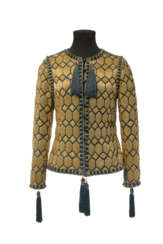jean jansem

Jean Jansem (Armenian: Ժանսեմ; French: Jean Jansem), real surname Hovhannes Semerdjian (Armenian: Հովհաննես Սեմերջյան; French: Hovhannes Semerdjian) was a French artist of Armenian origin. He studied at the Paris Academy of Decorative Arts.
From the very beginning, Jean Jansem has chosen the outcasts, the unfortunate, and the victims of the Armenian genocide as his inspiration. Zhansem is a consistent bearer of national historical memory, which he brought to the visual ranks throughout his life.


Jean Royère was a French designer.
A key figure of the avant-garde in the 1950s, Royère tackled all kinds of decoration work and opened branches in the Near East and Latin America. Among his patrons were King Farouk, King Hussein of Jordan, and the Shah of Iran, who were captivated by his freedom of creation and his elegance and entrusted him with the layout of their palaces. Royère pioneered an original style combining bright colors, organic forms and precious materials within a wide range of imaginative accomplishments. In 1980, he left France for the United States, where he lived until his death.


Jean Royère was a French designer.
A key figure of the avant-garde in the 1950s, Royère tackled all kinds of decoration work and opened branches in the Near East and Latin America. Among his patrons were King Farouk, King Hussein of Jordan, and the Shah of Iran, who were captivated by his freedom of creation and his elegance and entrusted him with the layout of their palaces. Royère pioneered an original style combining bright colors, organic forms and precious materials within a wide range of imaginative accomplishments. In 1980, he left France for the United States, where he lived until his death.








Franz Moritz Wilhelm Marc, a pivotal figure in German Expressionism, remains celebrated for his innovative contributions to 20th-century art. Born in Munich, Bavaria, within the German Empire on February 8, 1880, Marc's journey into the art world was profoundly influenced by his education at the Academy of Fine Arts in Munich. His distinct artistic vision is most famously encapsulated in works like "The Tower of Blue Horses", "Yellow Cow", and "Blue Horse I", each radiating with vibrant colors and emotional depth. Marc's affiliation with Der Blaue Reiter, a journal he co-founded, underscored his role in the German Expressionist movement, emphasizing the spiritual and symbolic significance of color in art.
Marc's oeuvre predominantly features animals, presented not merely as subjects but as embodiments of primal purity and emotional resonance. This choice of subject matter, combined with a stark, almost cubist portrayal, allowed Marc to explore themes of spirituality, masculinity (often symbolized by blue), and the tumultuous essence of life itself. His work "Fate of the Animals", which hangs in the Kunstmuseum Basel, exemplifies this thematic exploration, portraying a premonition of chaos and destruction that eerily anticipated the outbreak of World War I.
Tragically, Marc's promising career was cut short by his death at the Battle of Verdun on March 4, 1916, during World War I, where he served in the German Army. Despite his premature demise, Marc's legacy endures through his profound impact on modern art, as seen in his vibrant compositions that continue to captivate audiences in galleries and museums worldwide. His artworks, once labeled as "degenerate" by the Nazis, have transcended this vilification, achieving acclaim and fetching high sums at auction, with "Die Füchse (The Foxes)" reaching a record £42,654,500.
For collectors and experts in art and antiques, Marc's work represents not only a high point in German Expressionism but also a window into the artist's profound belief in the spiritual power of color and form. His legacy is a testament to the enduring allure and significance of early 20th-century modern art. To stay updated on sales and auction events related to Franz Marc's work, signing up for updates offers a direct link to the vibrant legacy of this remarkable artist.















![Jean-Baptiste Audebert | Histoire naturelle des singes. Paris, 1797-[1800], in the original parts, fine illustrations of primates](/assets/image/picture_3530743/97533/zll8szmoumzsdx86feof1b4xnhwzoiihymos91lyuesaxchvije5vgcl7ima5r1698925527jpg__fix_374_244.jpeg)
![Jean-Baptiste Audebert | Histoire naturelle des singes. Paris, 1797-[1800], in the original parts, fine illustrations of primates](https://veryimportantlot.com/assets/image/picture_3530743/97533/zll8szmoumzsdx86feof1b4xnhwzoiihymos91lyuesaxchvije5vgcl7ima5r1698925527jpg__fix_374_244.jpeg)











